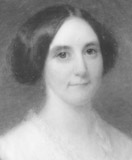#PrudenceOTP - HerStory
- theopentheatre
- Jan 7, 2018
- 3 min read
Updated: Mar 9, 2020
This blog was written by Historian, Beth Miller as part of our on-going series featuring the women of An Education in Prudence and the history behind the show.

Prudence Crandall was born in on September 3, 1803 to Pardon and Esther Crandall. She and her family lived in Hopkinton, Rhode Island, until Pardon moved the family to Canterbury in 1830. Pardon Crandall was a farmer, who was a Quaker and who believed in education for all of his children.
Prudence attended the Friend’s Boarding School in Providence, a well-regarded Quaker school. Quakers believed in equality between the sexes and encouraged women to speak at Meeting. Proactively sharing their opinions in the supportive atmosphere of Quaker meetings, gave Quaker women confidence in their opinions. Though Prudence often deferred to her male spokesmen during as the “Canterbury Affair” unfolded, she was resolute in her opinions about abolition and the right her students had to an education.

Quakers also denounced slavery and racism. It is very likely that her upbringing contributed significantly to these two ideas which lead to her actions in Canterbury: that women had the right to speak up and that blacks had the right to be free and to enjoy all democratic rights of freedom, namely, pursuit of an education.

Quakers believe that God is at work in each person via their conscience, and it was her conscience on the matter of women’s rights and abolition that lead her to the radical action of defying her Board of Trustees by first admitting Sarah Harris, and next, by escalating her defiance by reaching out to William Lloyd Garrison and enlisting this help in “exchanging her white girls for colored”.

After the first trial, Prudence continued to teach her students, the Canterburians continued to torment them, and Crandall met and married Reverend Calvin Philleo. Letters between Garrison and his fiancée, Helen Benson, reveal that they thought Calvin a man of dubious character who had a habit of proposing on a whim. Crandall, however, was smitten and may have felt luck, or relieved, to have met a man willing to marry her. During this era, at the age of 30, she was well on her way to spinsterhood, and her actions at the school put her at risk for being a national pariah.
The romantic development suggests the influence of societal expectations that women should marry. It is certainly possible that she loved Calvin, but the number and frequency of warnings against him from respected friends is telling. Prudence was a savvy and smart woman and yet she married a man of “dubious character”. Predictably, her marriage ended up an unhappy one. Calvin moved her to Ithaca, NY after the school dissolved, and then to Illinois, further separating her from her family. He even tried to forbid her to read certain books, according to her personal account.
Calvin Philleo died in 1874 and Prudence ended her life in Elk Falls, Kansas, where she lived in poverty until journalist George B. Thayer who was biking across the country, stopped by for a visit and wrote about her poverty. The article caught the eye and the ire of Mark Twain, who enlisted other Hartford, Connecticut luminaries, including Elizabeth Jarvis Colt, Sam Colt’s widow, and winning Prudence a $400 annual pension from the Connecticut State Legislature for her remaining years.

Don't forget to get your TICKETS NOW for OTP's An Education in Prudence - February 9-24 at St. John's Church, Jamaica Plain












Comments